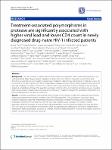Treatment-associated polymorphisms in protease are significantly associated with higher viral load and lower CD4 count in newly diagnosed drug-naive HIV-1 infected patients
Theys, Kristof
Deforche, Koen
Vercauteren, Jurgen
Libin, Pieter
Vijver, David A. M. C. van de
Albert, Jan
Åsjö, Birgitta
Balotta, Claudia
Bruckova, Marie
Camacho, Ricardo J.
Clotet, Bonaventura
Coughlan, Suzie
Grossman, Zehava
Hamouda, Osamah
Horban, Andrzei
Korn, Klaus
Kostrikis, Leondios G.
Kücherer, Claudia
Nielsen, Claus
Paraskevis, Dimitrios
Poljak, Mario
Puchhammer-Stockl, Elisabeth
Riva, Chiara
Ruiz, Lidia
Liitsola, Kirsi
Background: The effect of drug resistance transmission on disease progression in the newly infected patient is not well understood. Major drug resistance mutations severely impair viral fitness in a drug free environment, and therefore are expected to revert quickly. Compensatory mutations, often already polymorphic in wild-type viruses, do not tend to revert after transmission. While compensatory mutations increase fitness during treatment, their presence may also modulate viral fitness and virulence in absence of therapy and major resistance mutations. We previously designed a modeling technique that quantifies genotypic footprints of in vivo treatment selective pressure, including both drug resistance mutations and polymorphic compensatory mutations, through the quantitative description of a fitness landscape from virus genetic sequences. Results: Genotypic correlates of viral load and CD4 cell count were evaluated in subtype B sequences from recently diagnosed treatment-naive patients enrolled in the SPREAD programme. The association of surveillance drug resistance mutations, reported compensatory mutations and fitness estimated from drug selective pressure fitness landscapes with baseline viral load and CD4 cell count was evaluated using regression techniques. Protease genotypic variability estimated to increase fitness during treatment was associated with higher viral load and lower CD4 cell counts also in treatment-naive patients, which could primarily be attributed to well-known compensatory mutations at highly polymorphic positions. By contrast, treatment-related mutations in reverse transcriptase could not explain viral load or CD4 cell count variability. Conclusions: These results suggest that polymorphic compensatory mutations in protease, reported to be selected during treatment, may improve the replicative capacity of HIV-1 even in absence of drug selective pressure or major resistance mutations. The presence of this polymorphic variation may either reflect a history of drug selective pressure, i.e. transmission from a treated patient, or merely be a result of diversity in wild-type virus. Our findings suggest that transmitted drug resistance has the potential to contribute to faster disease progression in the newly infected host and to shape the HIV-1 epidemic at a population level.
Dateien zu dieser Publikation
Keine Lizenzangabe
Verwandte Publikationen
Anzeige der Publikationen mit ähnlichem Titel, Autor, Urheber und Thema.
-
2015-11-10ZeitschriftenartikelComparison of the Cowpox Virus and Vaccinia Virus Mature Virion Proteome: Analysis of the Species- and Strain-Specific Proteome Döllinger, Jörg; Schaade, Lars; Nitsche, AndreasCowpox virus (CPXV) causes most zoonotic orthopoxvirus (OPV) infections in Europe and Northern as well as Central Asia. The virus has the broadest host range of OPV and is transmitted to humans from rodents and other wild ...
-
2009-10-16ZeitschriftenartikelLack of evidence for xenotropic murine leukemia virus-related virus(XMRV) in German prostate cancer patients Hohn, Oliver; Krause, Hans; Barbarotto, Pia; Niederstadt, Lars; Beimforde, Nadine; Denner, Joachim; Miller, Kurt; Kurth, Reinhard; Bannert, NorbertBackground: A novel gammaretrovirus named xenotropic murine leukemia virus-related virus (XMRV) has been recently identified and found to have a prevalence of 40% in prostate tumor samples from American patients carrying ...
-
2011-10-19ZeitschriftenartikelGrowth of influenza A virus is not impeded by simultaneous removal of the cholesterol binding and acylation sites in the M2 protein Thaa, Bastian; Tielesch, Claudia; Möller, Lars; Schmitt, Armin O.; Wolff, Thorsten; Bannert, Norbert; Herrmann, Andreas; Veit, MichaelInfluenza virus assembly and budding occur in the 'budozone', a coalesced raft domain in the plasma membrane. The viral transmembrane protein M2 is implicated in virus particle scission, the ultimate step in virus budding, ...

